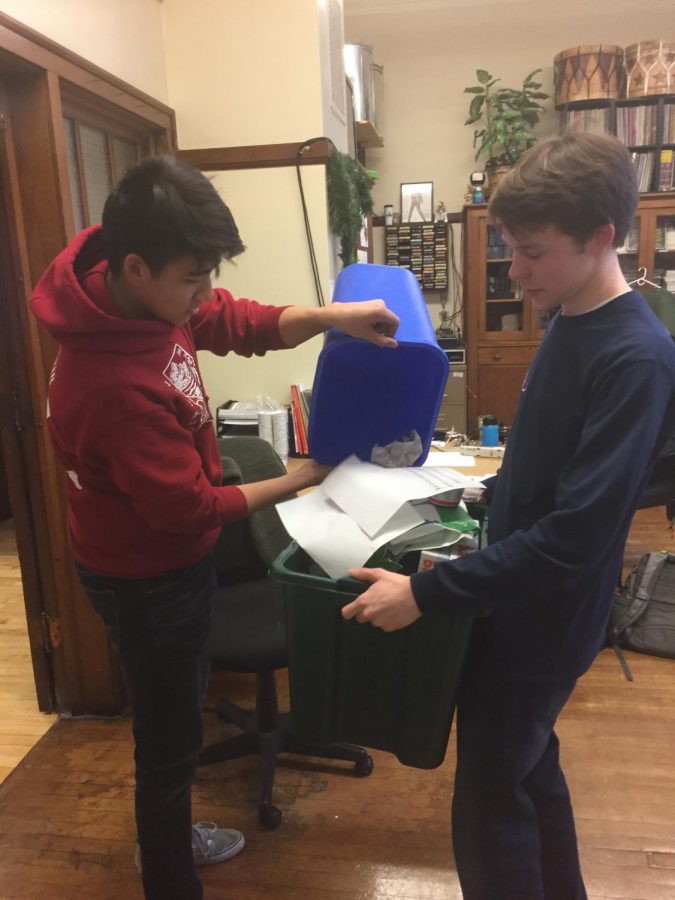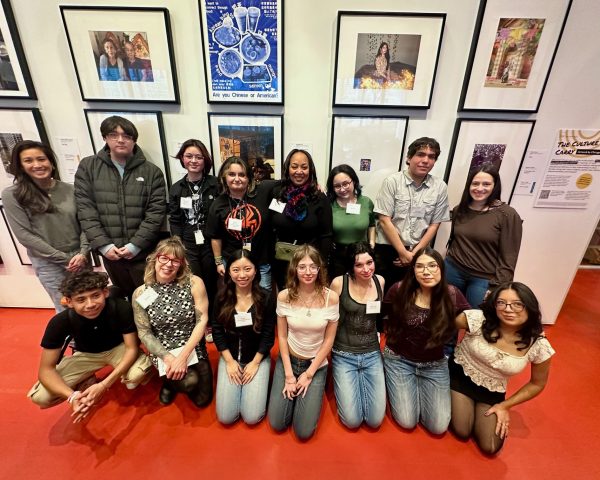Small changes for a smaller carbon footprint
Jack Kelleher, left, and Justin Rowe take trash to recycle from the band room. The Environmental Club meets during the week to collect recycling from around the school, to improve Lane’s carbon footprint.
From turning on the lights to printing a piece of paper, there is no doubt that Lane’s carbon footprint — its contribution of pollution to the environment — comes from many different sources, every single day.
In a world that is trying to become greener every day, Lane is starting to make adjustments in the building that reduce its contribution to climate change.
Mr. Wawrzyczek, an AP Environmental Science teacher, noted that the school building isn’t the only source of a school’s pollution.
“To actually figure out the full carbon footprint of Lane Tech would be complicated, but I would say it is probably lower than many suburban districts,” Wawrzyczek said.
Suburban schools generally have a higher footprint because students drive farther whereas many students at Lane use public transportation, according to Wawrzyczek.
Building operations manager Rene Luis described the footprint as quite large due to the size of the school.
Given Lane’s large footprint, many small things are being done within the building to help reduce emissions.
According to Luis, by remodeling a portion of the windows and doors, Lane is also now better insulated and relies on less heating, which helps in reducing emissions.
Lane has also changed from fluorescent lights to LED lights, which only need to be replaced every 11-20 years.
Additionally, all toilets are now “low flow toilets,” meaning they use fewer gallons of water when flushing, according to Luis.
While Lane is making these adjustments to their carbon footprint, other schools in CPS are as well. CPS recently launched a “Go Green” Environmental Action Plan, where they list goals and methods to help reduce the footprint in a number of ways, including energy and water.
The Go Green Website offers information on different initiatives within CPS. It also provides statistical information relating to water and energy use for each school.
Grant Koch, Div. 956, is the co-president of the Environmental Club and manages the recycling around the school.
The Environmental Club goes around the school collecting recycling a few times a week.
Koch has also started the movement “Lightless Tuesday,” where teachers do not use classroom lights on Tuesday, relying on natural sunlight instead.
According to Luis, Lightless Tuesday has helped immensely in terms of lowering Lane’s footprint.
Doing small, simple things to help does not have a huge impact on current day-to-day life for students, according to Luis. Making bigger adjustments to lower our carbon footprint may require adjustments for students and faculty.
“It’s really difficult when looking at schools, because if you are trying to become more efficient it’s easy, but without putting a significant debt to the teacher or to the resources allotted for the students, it’s somewhat difficult to do that,” Wawrzyczek said.
According to Wawrzyczek, to make a serious, efficient move schoolwide would be difficult.
However, there are teachers at Lane making major adjustments in their classrooms in an effort to reduce Lane’s carbon footprint.
For example, there are a handful of classes that are paperless.For assignments and quizzes, some teachers prefer online documents as a method of teaching.
“Doing this is significantly more efficient for teachers and is usually easier to grade as well,” Wawrzyczek said.
The best way to reduce emissions would be a one-to-one computing environment for students, where there is a computer for every student, according to Wawrzyczek.
In addition, implementing these ideas to lower the footprint is often costly.
“If I were to convert lights to LED, we would need ballasts, labor and overall, it costs money,” Luis said. “So, in the long run, we save that money, but you won’t see that money in the first five years, but after ten or 15 years.”
Nonetheless, these small improvements such as Lightless Tuesday and recycling improvements are being made by students and teachers everyday.
“Those little things help us move towards reducing our carbon footprint,” Luis said.
Your donations directly fund the Lane Tech student journalism program—covering essential costs like website hosting and technology not supported by our school or district. Your generosity empowers our student reporters to investigate, write, and publish impactful stories that matter to our school community.
This website is more than a publishing platform—it's an archive, a research tool, and a source of truth. Every dollar helps us preserve and grow this resource so future students can learn from and build on the work being done today.
Thank you for supporting the next generation of journalists at Lane Tech College Prep!

Ben Griffin is a Senior at Lane Tech and the Opinions Editor. In his second year with the Warrior, Griffin originally took the course to further his writing...




